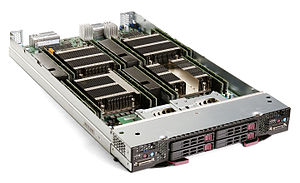
Back Свръхкомпактен модулен сървър Bulgarian Servidor blade Catalan Bladeserver Danish Bladeserver German Klingo-servilo EO Servidor blade Spanish Labaserver ET سرور تیغهای FA Serveur lame French Bilah peladen ID

A blade server is a stripped-down server computer with a modular design optimized to minimize the use of physical space and energy. Blade servers have many components removed to save space, minimize power consumption and other considerations, while still having all the functional components to be considered a computer.[1] Unlike a rack-mount server, a blade server fits inside a blade enclosure, which can hold multiple blade servers, providing services such as power, cooling, networking, various interconnects and management. Together, blades and the blade enclosure form a blade system, which may itself be rack-mounted. Different blade providers have differing principles regarding what to include in the blade itself, and in the blade system as a whole.
In a standard server-rack configuration, one rack unit or 1U—19 inches (480 mm) wide and 1.75 inches (44 mm) tall—defines the minimum possible size of any equipment. The principal benefit and justification of blade computing relates to lifting this restriction so as to reduce size requirements. The most common computer rack form-factor is 42U high, which limits the number of discrete computer devices directly mountable in a rack to 42 components. Blades do not have this limitation. As of 2014[update], densities of up to 180 servers per blade system (or 1440 servers per rack) are achievable with blade systems.[2]
- ^ "Data Center Networking – Connectivity and Topology Design Guide" (PDF). Enterasys Networks, Inc. 2011. Archived from the original (PDF) on 2013-10-05. Retrieved 2013-09-05.
- ^ "HP updates Moonshot server platform with ARM and AMD Opteron hardware". Incisive Business Media Limited. 9 Dec 2013. Archived from the original on 16 April 2014. Retrieved 2014-04-25.